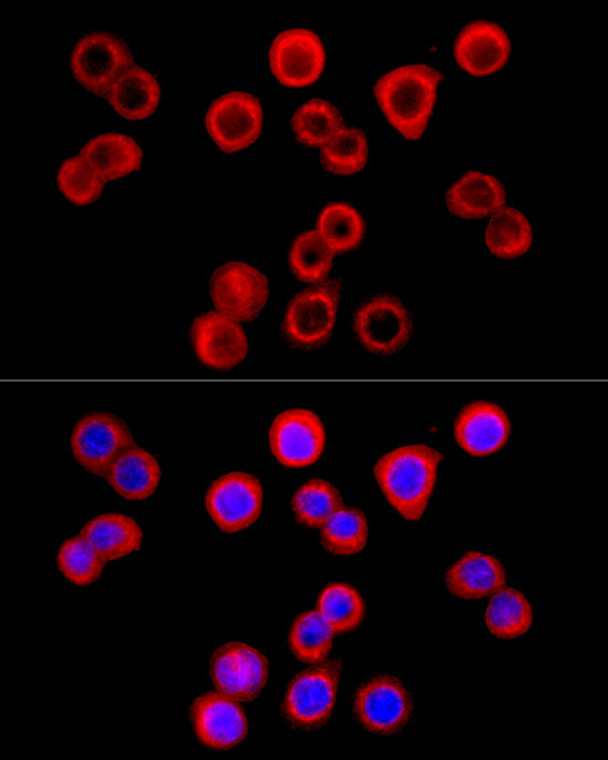| Host: |
Rabbit |
| Applications: |
WB/IHC/IF |
| Reactivity: |
Human/Mouse/Rat |
| Note: |
STRICTLY FOR FURTHER SCIENTIFIC RESEARCH USE ONLY (RUO). MUST NOT TO BE USED IN DIAGNOSTIC OR THERAPEUTIC APPLICATIONS. |
| Short Description: |
Rabbit polyclonal antibody anti-RIPK3 (21-287) is suitable for use in Western Blot, Immunohistochemistry and Immunofluorescence research applications. |
| Clonality: |
Polyclonal |
| Conjugation: |
Unconjugated |
| Isotype: |
IgG |
| Formulation: |
PBS with 0.01% Thimerosal, 50% Glycerol, pH7.3. |
| Purification: |
Affinity purification |
| Dilution Range: |
WB 1:500-1:2000IHC-P 1:50-1:200IF/ICC 1:50-1:200 |
| Storage Instruction: |
Store at-20°C for up to 1 year from the date of receipt, and avoid repeat freeze-thaw cycles. |
| Gene Symbol: |
RIPK3 |
| Gene ID: |
11035 |
| Uniprot ID: |
RIPK3_HUMAN |
| Immunogen Region: |
21-287 |
| Immunogen: |
A synthetic peptide corresponding to a sequence within amino acids 21-287 of human RIP3 (NP_006862.2). |
| Immunogen Sequence: |
LENQELVGKGGFGTVFRAQH RKWGYDVAVKIVNSKAISRE VKAMASLDNEFVLRLEGVIE KVNWDQDPKPALVTKFMENG SLSGLLQSQCPRPWPLLCRL LKEVVLGMFYLHDQNPVLLH RDLKPSNVLLDPELHVKLAD FGLSTFQGGSQSGTGSGEPG GTLGYLAPELFVNVNRKAST ASDVYSFGILMWAVLAGREV ELPTEPSLVYEAVCNRQNRP SLAELPQAGPETPGLEGLK |
| Tissue Specificity | Highly expressed in the pancreas. Detected at lower levels in heart, placenta, lung and kidney. Isoform 3: Expression is significantly increased in colon and lung cancers. |
| Post Translational Modifications | (Microbial infection) Proteolytically cleaved by S.flexneri OspD3 within the RIP homotypic interaction motif (RHIM), leading to its degradation and inhibition of necroptosis. RIPK1 and RIPK3 undergo reciprocal auto- and trans-phosphorylation. Autophosphorylated following interaction with ZBP1. Phosphorylation of Ser-199 plays a role in the necroptotic function of RIPK3. Autophosphorylates at Ser-227 following activation by ZBP1: phosphorylation at these sites is a hallmark of necroptosis and is required for binding MLKL. Phosphorylation at Thr-182 is important for its kinase activity, interaction with PELI1 and PELI1-mediated 'Lys-48'-linked polyubiquitination and for its ability to mediate TNF-induced necroptosis. Polyubiquitinated with 'Lys-48' and 'Lys-63'-linked chains by BIRC2/c-IAP1 and BIRC3/c-IAP2, leading to activation of NF-kappa-B. Polyubiquitinated with 'Lys-48'-linked chains by PELI1 leading to its subsequent proteasome-dependent degradation. Ubiquitinated by STUB1 leading to its subsequent proteasome-dependent degradation. |
| Function | Serine/threonine-protein kinase that activates necroptosis and apoptosis, two parallel forms of cell death. Necroptosis, a programmed cell death process in response to death-inducing TNF-alpha family members, is triggered by RIPK3 following activation by ZBP1. Activated RIPK3 forms a necrosis-inducing complex and mediates phosphorylation of MLKL, promoting MLKL localization to the plasma membrane and execution of programmed necrosis characterized by calcium influx and plasma membrane damage. In addition to TNF-induced necroptosis, necroptosis can also take place in the nucleus in response to orthomyxoviruses infection: following ZBP1 activation, which senses double-stranded Z-RNA structures, nuclear RIPK3 catalyzes phosphorylation and activation of MLKL, promoting disruption of the nuclear envelope and leakage of cellular DNA into the cytosol. Also regulates apoptosis: apoptosis depends on RIPK1, FADD and CASP8, and is independent of MLKL and RIPK3 kinase activity. Phosphorylates RIPK1: RIPK1 and RIPK3 undergo reciprocal auto- and trans-phosphorylation. In some cell types, also able to restrict viral replication by promoting cell death-independent responses. In response to Zika virus infection in neurons, promotes a cell death-independent pathway that restricts viral replication: together with ZBP1, promotes a death-independent transcriptional program that modifies the cellular metabolism via up-regulation expression of the enzyme ACOD1/IRG1 and production of the metabolite itaconate. Itaconate inhibits the activity of succinate dehydrogenase, generating a metabolic state in neurons that suppresses replication of viral genomes. RIPK3 binds to and enhances the activity of three metabolic enzymes: GLUL, GLUD1, and PYGL. These metabolic enzymes may eventually stimulate the tricarboxylic acid cycle and oxidative phosphorylation, which could result in enhanced ROS production. (Microbial infection) In case of herpes simplex virus 1/HHV-1 infection, forms heteromeric amyloid structures with HHV-1 protein RIR1/ICP6 which may inhibit RIPK3-mediated necroptosis, thereby preventing host cell death pathway and allowing viral evasion. |
| Protein Name | Receptor-Interacting Serine/Threonine-Protein Kinase 3Rip-Like Protein Kinase 3Receptor-Interacting Protein 3Rip-3 |
| Database Links | Reactome: R-HSA-168927Reactome: R-HSA-1810476Reactome: R-HSA-2562578Reactome: R-HSA-3295583Reactome: R-HSA-5213460Reactome: R-HSA-5675482Reactome: R-HSA-9013957Reactome: R-HSA-937041Reactome: R-HSA-9686347Reactome: R-HSA-9692913Reactome: R-HSA-9692916 |
| Cellular Localisation | CytoplasmCytosolNucleusMainly CytoplasmicPresent In The Nucleus In Response To Influenza A Virus (Iav) Infection |
| Alternative Antibody Names | Anti-Receptor-Interacting Serine/Threonine-Protein Kinase 3 antibodyAnti-Rip-Like Protein Kinase 3 antibodyAnti-Receptor-Interacting Protein 3 antibodyAnti-Rip-3 antibodyAnti-RIPK3 antibodyAnti-RIP3 antibody |
Information sourced from Uniprot.org
12 months for antibodies. 6 months for ELISA Kits. Please see website T&Cs for further guidance














